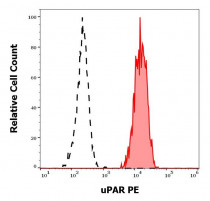ARG42454
anti-uPAR antibody [VIM5] (PE)
anti-uPAR antibody [VIM5] (PE) for Flow cytometry and Human
Overview
| Product Description | PE-conjugated Mouse Monoclonal antibody [VIM5] recognizes uPAR |
|---|---|
| Tested Reactivity | Hu |
| Tested Application | FACS |
| Specificity | The mouse monoclonal antibody VIM5 recognizes CD87 (urokinase plasminogen activator receptor), a 36-68 kDa single-chain GPI-anchored extracellular glycoprotein expressed on granulocytes, monocytes/macrophages, dendritic cells, endothelial cells, fibroblasts and keratinocytes. |
| Host | Mouse |
| Clonality | Monoclonal |
| Clone | VIM5 |
| Isotype | IgG1 |
| Target Name | uPAR |
| Antigen Species | Human |
| Immunogen | Human myeloid cell line THP-1. |
| Conjugation | PE |
| Alternate Names | Monocyte activation antigen Mo3; CD antigen CD87; uPAR; U-PAR; URKR; Urokinase plasminogen activator surface receptor; UPAR; CD87 |
Application Instructions
| Application Suggestion |
|
||||
|---|---|---|---|---|---|
| Application Note | * The dilutions indicate recommended starting dilutions and the optimal dilutions or concentrations should be determined by the scientist. |
Properties
| Form | Liquid |
|---|---|
| Purification | Purified |
| Buffer | PBS and 15 mM Sodium azide. |
| Preservative | 15 mM Sodium azide |
| Storage Instruction | Aliquot and store in the dark at 2-8°C. Keep protected from prolonged exposure to light. Avoid repeated freeze/thaw cycles. Suggest spin the vial prior to opening. The antibody solution should be gently mixed before use. |
| Note | For laboratory research only, not for drug, diagnostic or other use. |
Bioinformation
| Database Links |
Swiss-port # Q03405 Human Urokinase plasminogen activator surface receptor |
|---|---|
| Gene Symbol | PLAUR |
| Gene Full Name | plasminogen activator, urokinase receptor |
| Background | This gene encodes the receptor for urokinase plasminogen activator and, given its role in localizing and promoting plasmin formation, likely influences many normal and pathological processes related to cell-surface plasminogen activation and localized degradation of the extracellular matrix. It binds both the proprotein and mature forms of urokinase plasminogen activator and permits the activation of the receptor-bound pro-enzyme by plasmin. The protein lacks transmembrane or cytoplasmic domains and may be anchored to the plasma membrane by a glycosyl-phosphatidylinositol (GPI) moiety following cleavage of the nascent polypeptide near its carboxy-terminus. However, a soluble protein is also produced in some cell types. Alternative splicing results in multiple transcript variants encoding different isoforms. The proprotein experiences several post-translational cleavage reactions that have not yet been fully defined. [provided by RefSeq, Jul 2008] |
| Function | Acts as a receptor for urokinase plasminogen activator. Plays a role in localizing and promoting plasmin formation. Mediates the proteolysis-independent signal transduction activation effects of U-PA. It is subject to negative-feedback regulation by U-PA which cleaves it into an inactive form. [UniProt] |
| Cellular Localization | Cell membrane. Cell projection, invadopodium membrane. Note=Colocalized with FAP (seprase) preferentially at the cell surface of invadopodia membrane in a cytoskeleton-, integrin- and vitronectin-dependent manner. Isoform 1: Cell membrane; Lipid-anchor, GPI-anchor. Isoform 2: Secreted. [UniProt] |
| Calculated MW | 37 kDa |
Images (2) Click the Picture to Zoom In
-
ARG42454 anti-uPAR antibody [VIM5] (PE) FACS image
Flow Cytometry: Human peripheral whole blood stained with ARG42454 anti-uPAR antibody [VIM5] (PE) at 10 µl / 100 µl of peripheral whole blood.
-
ARG42454 anti-uPAR antibody [VIM5] (PE) FACS image
Flow Cytometry: Separation of Human monocytes (red-filled) from lymphocytes (black-dashed). Human peripheral whole blood stained with ARG42454 anti-uPAR antibody [VIM5] (PE) at 10 µl / 100 µl of peripheral whole blood.







